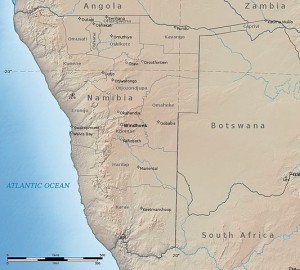Namibia trip, 16 March – 5 May 1995
The California Least Tern was a major player in my life for 25 years. And in addition to a long-term banding project in California that was pursued every summer, I was interested in where the birds wintered and in studying behavior and vocalizations of other small terns worldwide. So in the non-breeding season I did some fabulous travels – to Australia, Africa, Mexico and South America, seeking out other species.This could be the start of a long digression on tern-related travels so I’ll just say that the Damara Tern in Southern Africa was a species on my list and I finally did a 7-week trip to Namibia in 1995. Alas the timing was wrong, the logistics a huge challenge, and the mission was not a success. But it was one of the GREAT adventures in my adventure-filled life and is still vivid in memory. Happily I typed an account for the family and what follows is a short version of the trip.
In case you haven’t a clue about Namibia, and most of the rest of the world doesn’t, here is a sketchy map. Sketchy because Namibia is wonderfully underpopulated and has only one major city – Windhoek, with a population of about 300,000, and located in the middle of the country. It is wild and full of incredible wonders like the Namib Deser along the coast, and was one of the GREAT adventures in my adventure-filled life. It is still vivid in memory. Happily I typed an account for the family right after return, and what follows is a short version of that journal.
The Damara Tern nests on the coast at a huge distance from Windhoek, the capitol. I had a contact in Windhoek, Dr. Rob Simmons, an Ornithologist with the Namibian Dept. of Environment and Tourism, who had been studying the DamaraTern for 5 years and was very enthusiastic about my coming. He and his wife Phoebe Barnard, also an Ornithologist, are now both at the University of Capetown in South Africa. Rob is a noted field ornithologist, Phoebe has become a prominent researcher on climate-change. We enjoyed each others’ company very much and they were wonderfully helpful throughout. I lost track of them after a decade but recently found them by googling.
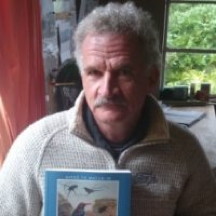
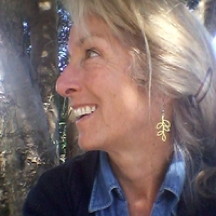
My companion was Ellen van Fleet, an artist who enjoyed birds and had a serious interest in rock art. (I just hunted thru my files and have no photos of her, amazingly enough.) In addition to tern research and rock-art exploration we both wanted to do watercolors and see the fauna and flora of Namibia. We had to schedule the trip for April to meet both Ellen’s and my needs, and it was truly a compromise. The rock art sites are only bearable in winter (May-Sept), and the tern breeding season is from Oct-June. So we were at the end of the tern season and only late nesting was in progress up the Skeleton Coast at Möwe Bay; the rock art sites were still sweltering, although endurable. I had a contact, Dr. Rob Simmons, an Ornithologist with the Dept. of Environment and Tourism, who had been studying these terns for the 5 years and was very enthusiastic about my coming. Rob set up a stay for us at the Möwe Bay research station, 500km north of Swakopmund on the coast, where there was a tern breeding colony, and found an assistant to go along – Annette Sheppard. She was a volunteer in his lab, a social worker from Britain who was taking a year off to decide what to do with the rest of her life and up for adventures. Under Rob’s guidance we rented a ‘backie with a canopy’ which translates in US jargon to a ‘pickup with a camper shell’. A nice little Mazda, good mileage, it served us well throughout the trip. The Simmons supplied us with a tarp, mat and duvet, large water containers, cups, etc. and we headed for the coast (280 km), Bob and Annette following in his Land Rover.
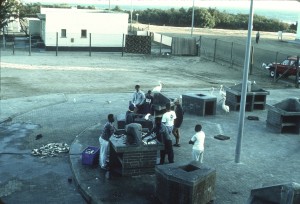
Spent the night in Swakopmund on the coast because the next leg of the trip was 500km north on a dirt road. Walked the town in the evening and wanted to stay a few days – not possible, but we did so on the way back. Bought groceries for a 2-wk stay, loaded a 3-wheeler into Rob’s LandRover, and then headed north up the coast to Skeleton Coast National Park. We crossed 5 rivers with Herero names, Ugab, Huab, Koigab, Uniab and Hoanib, all dry but the Uniab which was troublesome. When it storms inland the rivers run to the coast and can cause major crossing problems. There are no bridges and the clayey soil gets slick, easy to get stuck in. Branches and rocks had been tossed into the Uniab to give it a roadbed, and Annette drove our pickup across with admirable skill and bravado. As we drove north the terrain changed from pervasive gray to pink, buff and gray dunes, and gray rocky outcrops. Bright green grasses and flowers from the recent rains speckled the landscape. Black-backed Jackals on a dune were silhouetted against the darkening sky.
We got to Möwe Bay in a magical twilight, and Ellen and I walked down to the sea to watch the surf pounding on black rocks, Cape Seals, White-breasted Cormorants and Kelp Gulls. The skeleton Coast is so-named for the many wrecks near or onshore. We did lots of painting everywhere we went and here are two of mine at Möwe Bay.
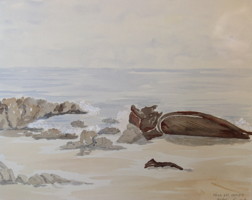
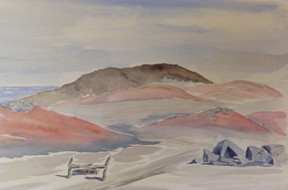
The research station consisted of the ranger’s house, some outbuildings and several guest houses. Our cottage had two bedrooms, living room, big kitchen, and bathroom with a shower and hot water. The generator usually turned off around 7PM and by morning the contents of the refrigerator were barely cool. Milk and meat didn’t last very long. We read and ate by candlelight. Nights were utterly dark and quiet, not even refrigerator noise; the sky luminous, with the Milky Way stretched from horizon to horizon. A huge round nebula glowed west of it – totally new to us northerners; the Southern Cross hung just above the horizon, Orion was right overhead. The landscape was vast, empty, lonesome, mesmerizing. Ellen and I painted daily and the ones here are mostly mine.
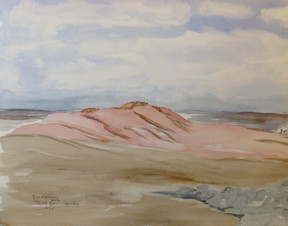
At dawn next day I walked into the desert accompanied by the ranger’s two mutts, a quarter moon and Venus. To the east a series of roadless dunes appeared under the lightening sky. The sun came up properly in the east, but then proceeded to traverse the northern sector of the sky, which was totally disconcerting for weeks. At noon our shadows were south of us. After breakfast we took two cars to the “airstrip”, a cleared area where the president flies in when he vacations here. (Rugged – not to be imagined for any U.S. President since Teddy Roosevelt.) Immediately a Damara Tern flew in and feed a chick. What a thrill. We found a nest and marked it with a cairn in this landmarkless terrain. The few nests we found were behind the first line of dunes, utterly exposed to predation by the resident jackals, if they could find them. Around noon Rob drove us over a rough track to a bluff over the Huanib River (dry) just to sightsee. A vast, dry, sandy river bed, great pebbles on the slopes. Found a porcupine quill and a Pied Crow nest with three young. Felt extraordinarily alone, I’d only experienced such vast solitude in Alaska. The heat was intense, the sky brilliantly clear, the day memorable. Rob and Annette went off in the afternoon and found another nest. But it was definitely end of season. A few chicks around, being fed, sporadic fish flights and courtship feeding. I already knew it was too late to do a proper study.
Rob left the following morning for Windhoek. He was wonderful, he set up my whole study, got the permits, got Annette back from Capetown to help me, and then drove all the way to Möwe Bay to get us oriented. He is a facilitator, like Charlie Collins maybe even more so. He and Phoebe love guests, find less stimulus in Windhoek than they need, and get it from visitors.
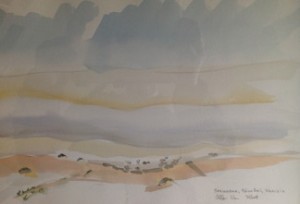
The landscape was vast, empty, lonesme, mesmerizing. An occasional jackal trotted along a regular route, a few Springbok used a transient waterhole and Ellen caught the scene really well.The Springbok are the tiny specks in the lower center, so miniscule they can hardly be detected.
The days fell immediately into a wonderful routine, Annette and I leaving at daylight on the 3-wheeler to nest watch until noon. An occasional jackal trotted along a regular route parallel to the sea. Ellen up and off at daylight on a 4-5 hr cross country hike, which thrilled her. She found Möwe Bay a marvelous, magical place. We traded paintings at the end of the trip and here is one Ellen did of Springbok a few Springbok at a transient waterhole – she caught the scene really well. PHOTO of Spring bok One day she hiked way up the Hoanib River and found a hillside covered with thunderstones. We all reconvened at the house for lunch, siesta in the hot afternoon, then to take off somewhere to paint. The choices are wonderful – pink dunes, deep-blue waterholes, rocky coastline, exotic plants. In the evening we read, write up field notes, keep logs, talk desultorily.
I began to have problems with the brand new cassette recorder after two days, and then it just quit working. We radioed Rob in Windhoek that night, and asked him for help. There was no phone, only radio contact twice a day. He called Des and Jen Bartlett, documentary filmmakers who were supposed to come up later in the week. They had a house, or rather a storage facility where they can sleep and keep equipment, and the only private dwelling at Möwe Bay. Des had a Sony recorder and mike he would be glad to lend me. So for the next few days I observed and took notes on behavior and incubation times, feeling pretty frustrated.
Except for the fact that the study was being shot out from under me, it was glorious. I learned to ride the bike, which was fun. Explored a boneyard that had skulls of elephant, rhino, giraffe and lots of horns – Springbok, Kudu and Gemsbok (Oryx). Traipsed north along the shore and painted the famous shipwreck, now a few tattered iron remains, but very picturesque. Glorious sunsets. Took my first tumble, messed up my right knee, ugh.
The Bartletts were delayed till Sunday. That was bad news since we had to leave on Monday because we were running out of food. Our meals were getting very creative, rice and veggies with curry (our only seasoning) and rationing in between meals. Milk gone, bread very stale. And the cottage was booked for Tuesday. We also were beginning to worry a bit about the weather. Heavy storms were reported inland, and some of the rivers were flooding and our vehicle does not have 4-wheel drive.
On Saturday we saw a huge storm inland, and got a strong wind from it. On Sunday the Bartletts arrived around noon in 3 vehicles, with daughter Julie and 6-yr old grandson Tarl. Des, a very pleasant and easy-going man, dug out his Sony mini-cassette recorder and we found it needed a 2hr charge. In the middle the generator went off, and we took the recorder down to their house where he charged it on his car battery. But fully charged it would neither record nor play, same as mine. I gave up, particularly since an even bigger sandstorm was enveloping us, with a huge dark electrical storm inland. The sandstorm now precludes any observing or recording. We began wondering whether we would get out at all tomorrow. The generator here broke down completely and there is barely had radio contact.
We enjoyed 6-yr old Tarl, who lives in Norfolk but has been coming here since birth. He finds scorpions, rocks, bones. They had a small chameleon they found on the airstrip and it was a demon fly eater. When held and directed towards a fly the tongue would snake out – end of fly. Des was planning to film it. It did in over 50 flies while we were all playing with it. We showed him a Trac-trac (thrush) nest with two large chicks, and he decided to film the parents feeding them. They have to deliver 5 1hr films to the National Geographic Society by December, so we will be seeing more of the Namib Desert on PBS. I asked him if he was interested in filming the Damara Tern and he was, but not soon.
Monday was a wild and memorable day. It was crisp and clear and we headed south and crossed the Hoanib and an unnamed river without difficulty, but on arrival at Terrace Bay (100 km south) were told Uniab was uncrossable with a conventional car and recommended we stay the night. So we ate lunch there and it was delectable. Fresh fish, fries, salad and ice cream, most welcome after so many rice pilafs. Booked two rooms in the deserted camp, great quarters right on the ocean. Ellen showered and Annette and I were preparing to go for a swim when a ranger raced in and said we would be escorted across the river if we left right away. We tore down the coast 30 km to the Uniab, and were towed across.
The rest of the day was surreal. Muddy, tired and exhilarated we headed inland to Korixas (pronounced Korikas with a gutteral ‘k’) as the direct route south to Swakopmund was out – the Huab River would be uncrossable for a week. As we drove east on a good gravel road the landscape became a wonderland – vast, with stark, red-rock mesas and plains with a gentle film of green grass.? PHOTO Rain is almost non-existent in the Namib Desert but there had recently been storms, and the desert was in bloom!! And suddenly we all realized that we were seeing Welwitschia everywhere! This totally unique plant was on our list of special items to find. It is a monotypic genotype and has only two leaves, but they can grow phenomenally long, making a giant twisted mass.They grow continuously throughout the life of the plant and can be 4 meters long. Both male and female plants were in flower, some of them huge, and so ugly they were magnificent. They are endemic to southeastern Africa, and are one of the world’s oldest and most unique plants. We stopped although the wind was fierce, and wandered, and photographed. Seeing them in bloom was a truely rare experience, and our cameras so crude compared to those available 2 decades later, that our photos hardly capture the astonishment scene we saw.
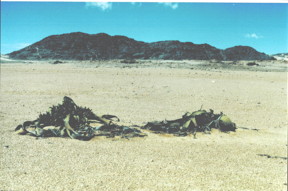
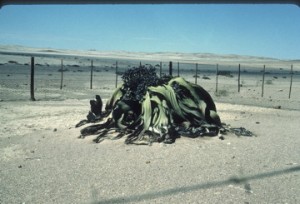
Drove on until dusk without seeing a single car or human abode and then just stopped on the road to spend the night. Our food supplies were minimal – cold baked potatoes, crackers and a container of warm juice! But lots of water. We were still full of the big lunch anyway. We bedded down in the back of the truck, using a foam pad and Ellen’s airmat, and somehow slept soundly, lined up like little sardines. Where else in the world can one sleep on a secondary road without anyone passing by, and without fear? Larks were nesting in the grasses and we heard lark song until dark and at first light. (There are many larks in southern Africa and I never got an ID on this one.)
Reached Swakopmund the next afternoon and booked into a wonderful two-star hotel, the Adler. Enjoyed the perks of civilization for two days while organizing for the rock art segment of the trip. Drove down to Walvis Bay late in an afternoon for some super birding. The sewage ponds are called “Bird Paradise” and indeed they are – we saw 16 species, including White-winged Tern, Maccoa Duck, Black-necked Grebe, Purple Gallinule. Drove on past dune-locked lagoons hosting thousands of Greater Flamingos. The wind was fierce so we had to sketch from the car. This is the Namib Desert as seen on postcards, and we skirted it on our way back to Winhoek. I also got a book called ‘The Sheltering Desert’ by Henno Martin, one of the best reads ever. He was a young German Geologist working in Namibia at the start of World War II and Germans were being interned for the duration. He had already decided the war was insanity and the European turmoil was not even of interest to him, so he and a friend and a dog acquired a lorry and let for the Namib Desert. They spent several years there, finding water sources, learning to hunt game for food, enduring every kind of weather except snow, and did not turn themselves in until the last year of the war. Theirs was an incomparable adventure, and the book is unique in my experience. I just googled it and it can be downloaded free, or bought for about $30.
We said goodbye to Annette that night, she hugged me and wanted to be sure to keep in touch. But have not seen nor hear from her since.
The second half of our trip was an exploration of rock art sites, for which Ellen was thoroughly prepared. The Erongebergs, Spitzkoppe, the Brandberg and Twyfelfontein were the four sites she had chosen. We returned to Windhoek for two days and shopped for books, topos of the rock art sites, and food for the trip. Ellen let Rob and Phoebe choose one of her paintings as a thank-you gift and Rob chose one of the little springbok herd at Möwe Bay and they were both tickled. Dined on pasta and wine at Marco’s, where we lunched the first day. Our last good meal for some days.
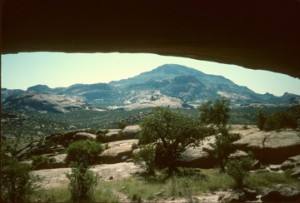
Stayed first in a bungalow at Ameib Ranch. Great birds all around the grounds – Grey Lourie, Red-faced Lovebird, Acacia Pied Barbet. The ranch has a bunch of rock art sites, only two of which are open to the public – Phillips’ Cave and the Bull Party.The owner was a German woman who was very proprietary about her rock art, and not at all helpful to Ellen. The country here is basin and range like SE Arizona, with vast grassy (now, at least) plains and rocky inselbergs rising from them. The colors are rich burnt siennas and paler beiges. The San (Bushmen) camped close to waterholes and painted on flat surfaces, usually with some protection, either in a cave or under an overhang. Except at Twyfelfontein where the rock art is petroglyphs, on flat vertical slabs often totally unprotected – but still near a perennial spring.
Phillips Cave was high up a mountainside and the paintings included two elephants, several giraffes, a line of human figures. I found them disappointing, faint and simplistic. But Ellen liked them, which is all that really mattered. Then the Bull Party, fantastic, huge rust-colored boulders and a running stream. We couldn’t find the paintings, though. I birded all day and at dusk we walked down to a dammed lake hoping to see some game. Waterbirds but no animals. Dinner was long-table style and we had 4 German couples as companions. The meal was a hour in coming, and was a brie (BBQ) of kudu, lamb, beef, sausages and assorted salads. Hardly our style. But the Germans really liked it.
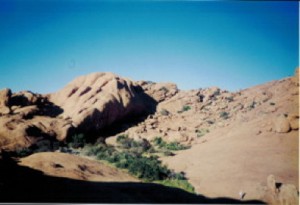
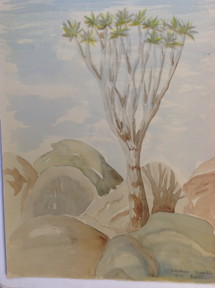
On the way to Spitzkoppe a troop of Meerkats bounded across the road and vanished in the tall grass. Spitzkoppe is incomparable. One of my favorite places, this inselberg is a cluster of jagged, rugged rock masses of great beauty. The ground between and amongst them is flat, richly vegetated with Acacias, Kokerboom, Cyphostemma and many other exotic trees we couldn’t identify. Kokerboom was another indigenous plant we wanted to see. The San people made quivers for their arrows from the stems. Grasses were up to our knees and dense, a soft grey rippling wave in the wind. A post-rain bloom of annuals.
The rock art was maddeningly well hidden and after two fruitless searches we finally asked Lena, one of the ladies who was tending the camp, to guide us. She led us to a great pictograph of a giraffe-headed snake in a cave we would never have looked into. There was a Sand Martin nest just above it. Ellen sketched while the birds flew in and out, feeding their chicks. I sat in an adjacent cave and painted, staying out of the burning afternoon sun. A White-throated Canary was feeding young in a nest at the cave entrance. Saw lots of chicks here – including Yellow-bellied Eremomela, Black-chested Prinia.
Lena also showed us two swimming holes, deep ovals in rock slabs the were filled with cold water. We took a marvelous swim in late day and then slept out under the swelling moon and stars.
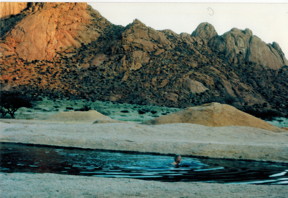
Another cave was 500′ up a steep cliff with a cable to help you ascend. In a hanging valley with a spring and stream there was a long overhang with interesting rock art, called Bushman’s Paradise. I found a Dassie skull (Hyrax) there. We painted Kokerbooms and Cyphostemma and didn’t want to leave.
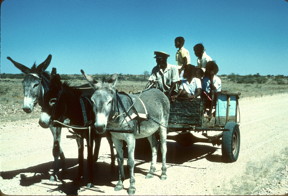
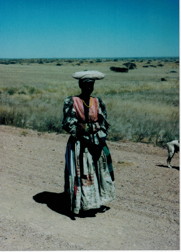
En route to Uis and the Brandberg Range we saw no auto traffic, but had some niftly meetings with some of the residents including a donkey cart full of kids driven by an old gentleman. We stopped and Ellen took a Polaroid to give them, while I snapped away with my camera. The kids whooped with delight as the film developed in front of them. Later on the way back to Uis on Easter Sunday there was a Herero woman tending goats and we took her picture with the Polaroid to her utter delight. Found out later when we tried to buy more film that Polaroid boycotted SA during the apartheid years and so noone had a camera anymore. No wonder it was such a treat for our subjects.
At Uis we were told that everything would be closed the next 4 days for the Easter holiday and we had to instantly revise our plans. Couldn’t go on and camp without supplies and all we could get were cheese and rolls and canned meat, enough for two days. We stayed at the rest camp, had a big meat and potatoes dinner in the dining room and a big breakfast next morning, and then set out for Tsaisab Gorge.
Started hiking to The White Lady at 9:30 and it was already too warm. A 2.5 km hike up a river dry bed that became a rushing stream. The White Lady is behind an iron grill but some vandalism was apparent from before protection. She is neither white nor a lady, having no tits and only the legs are white. Great setting and pretty good paintings. There are at least a dozen sites here and we tried to reach some in the searing heat, terribly hard going over huge boulders. We found the White Giraffe and then I holed in in a cool place and painted the view down the gorge. PHOTO Ellen went on and found Jochmann’s Shelter and what was for her a great figure. I joined her later, although it was still ferociously hot at 3:30. Then we climbed down to the stream and stripped and soaked in a pool with hordes of tadpoles.
Camped that night up a hill outside the gorge. Full moon, barking geckos, but hot and heavily mosquitoed. The geckos make a repetitive mechanical sound like no other. A grand setting but a long, uncomfortable night.
Next day again ferociously hot. The Brandberg is a hostile environment. It is now supposedly fall and cooler. Must be an inferno in the summer. Ellen was discouraged at being unable to find the paintings, and I was miserable from the heat and lack of sleep.We returned to Uis on Easter Sunday. Bought ‘stones’ from boys waiting at the road junction. Quartz with air bubbles, fluorite, amethyst. The hotel was a welcome retreat from the sun, and I stayed in and finished “The Sheltering Desert” in the afternoon. I was shocked to see how burnt I was and resolved to prevent future exposure from 11-4.
Next day we drove early to the Ugab River where we birded happily for 3 hrs. with lots of new species like Groundscraper Thrush, Greybacked Bleating Warbler, Swallowtailed Bee Eater. Painted in our room all afternoon. Walked to the abandoned tin mine after dinner. Uis is a ghost town, and later we saw a full page ad in the Windhoek paper about an auction of the WHOLE town, houses, mine, equipment, and shops. I wonder if anyone bought it.
Off to Twyfelfontein after an early shop in a pitifully understocked store. We got ice, fruit juices, bread, cheese and that was our fare again for several days. We both lost weight, no wonder. Arrived at Aba Huab Camp around noon, an astonishing site on the Huab (now dry) River. Our camp was under a spreading Acacia erioloba and there was running water at every camp and hot showers. Triangular thatched enclosures for sleeping, a bar with ice cold beer and coke. Far from anywhere but known to all the tour people. The rock art site is a rocky slope on the east side of a broad valley, and the petroglyphs are rather more carefully done and certainly better preserved than the pictographs we have seen.Here are photos from some of the rock art sites. I did not label them so am not sure now where they were taken. But they are typical of the places we climbed around in a wild, wild land.
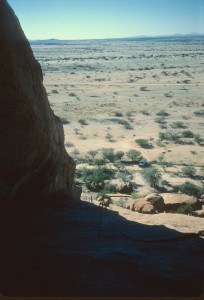
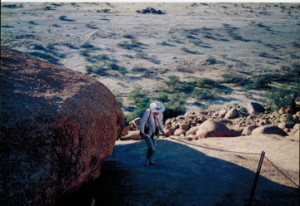
The third and final phase of the trip – north to Waterberg and Etosha National Parks for some wildlife viewing. No more camping. Guest farms, rest camps, and bungalows. And FOOD. First stop Korixas Rest Camp, rather expensive but most welcome. Pleasant poolside restaurant, with a huge palm tree that housed dozens of Lesser Masked and Red faced Weavers, all busy at their nests. We painted by the pool all afternoon and I did 3 duds, all too heavy and labored, all redone later. Good chicken dinner with wine and ice cream. For us it’s either feast or famine.
A gift shop at the entrance to the town of Outjo proved the best place we found to use our plastic. I bought a Mopane giraffe and walking stick for Eric, and jewelry for some of the girls. The giraffe is still in Eric’s room and the cane has resided in my car trunk forever. Stayed at a rest camp (Ombandi) that is being renovated by a young couple. Our bungalow was old but fine, a nice bar and a pool I plunged into. We took a late day walk to a cemetery, not great. But on the way back we met a batch of young boys and their dogs and had a great conversation. Flocks of Shaft-tailed and Pin-tailed Wydahs came in to roost in the trees near the camp. Our walk next morning to and around the sewage ponds was fabulous for birds – e.g. Crimson-breasted Shrike (the Namibian national bird) and Pearl-spotted Owl.
Our first big-animal experience was at Otjibamba Lodge, a guest farm south of Otjiwarango. Lovely place, one of our best accommodations. Our room was along a fence beyond which were Ostrich, Springbok, and Blesbok. We were able to paint them from our veranda. The game park was nifty – Ostriches, Giraffe, Kudu, Impala, Black Wildebeest, Waterbuck, Warthog and Springbok. One huge male Giraffe came walking straight towards the car, and only veered at the last minute. We could see his lovely eyelashes. Elegant eating in the lovely dining room, not expensive. It is cool and lovely, the weather having changed; fall must be really here.
We ordered coffee for 5:30 AM, and it came in china cups, such luxury. Walked the game farm for 2 1/2 hours and saw lots of new birds – Brubru, Melba Finch, Three-striped Tchaga. Breakfast was a delectable buffet, with fresh cantaloupe and grapes, bacon and eggs, even pretty good coffee. Spent the day walking, sketching, and eating good food. Took a nightwalk under a gorgeous starry sky, no moon.
Nexts stop Waterberg National Park. This huge tableland is an ecologically distinct island 1500′ above the surrounding thorn scrub. The cliffs are burnt sienna with splotches of wonderfully colored yellow-green algae. It has been protected for many years, and is now a site for trying to restore endangered species. There are de-horned rhinos and a vulture restaurant on top. No large carnivores, so I guess that makes it a good place for such species. In some ways Namibia is up to or ahead of the rest of the world on conservation; but sometimes, like with dehorning, there seems to be over-management. I doubt there were studies on the social impacts to rhinos of not having horns.
The camp is up on the south side of the mesa and we have a bungalow with patio, kitchen, 3 beds and a bath. Rustic and charming. There is a spectacular swimming pool that goes with the architecture yet is very contemporary. Not a lot of good architecture in the country, old or new. We cooked our own meals and enjoyed fresh morning coffee.
We spent two days here hiking and painting and birdwatching – the calls of the Grey Hornbill stay in my memory. Took a tour of the top and saw almost no wildlife except at a waterhole where there was a herd of Roan Antelope. Around camp the Dik Diks were almost tame, and baboons barked from the cliffs. At dusk there were several bush babies in the Acacias. Enchanting. In all, a great place.
The climax of the trip was Etosha National Park. We stayed outside the east gate the first night, as the park was fully booked. Mokuti Lodge is 4-star, and an Intrav group had just been here. Need I say more? No cross ventilation, dark room, but air conditioning and lots of other perks we didn’t appreciate. The big plus was the food. Huge buffets for dinner and breakfast, and almost gourmet. But the cost for one night was as much as 4 nights in the National Parks. At dinner that night Ellen wore her safari vest, the pockets lined with plastic baggies, and squirreled away chicken legs, roast beef slices, rolls, etc. She was great at this throughout the trip, would move serenely down the chow line overfilling her plate, and then discreetly stow it away at the table.
Drove into the park thru the Naumatomi Gate and it was GLORIOUS. Zebra, Giraffe, Springbok, Oryx, Blue Wildebeeste, Impala, and best of all 5 Kori Bustards and 2 Blue Cranes. Lenticular clouds, grass and water puddles everywhere. It was everything we yearned for, all in 3 hours. There are many waterholes strung along the 150 km road thru the park, and one never knows what will be at any of them. We found Aroe wonderful that first day, with a Tawny Eagle being mobbed by smaller birds, and a herd of Zebra. Fischer’s Pan was loaded with many species of ruminants. A marsh near Namuatomi was attracting Giraffes (very close) and waterbirds – Knob-billed Duck, Roseate Spoonbill, Red-billed Teal. I didn’t want to do anything but look. Photography and sketching could wait for another day.
The next day was, if anything, even more dazzling. Secretarybirds stalking thru the grasses, Kori Bustards on the plains. We saw most of the resident ruminants at Chudob and best of all a warthog came in to drink, kneeling to do so. The Giraffes had to spread their legs wide to get their heads to water. Kalkhuevel was also fine, and Reitfontein was special for birds. Three species of vultures roosting – White Backed, Lappet-faced, and Cape. Maribou and Abdim’s Stork in the grass. The vultures all went up and off at once, a great sight. At Halali waterhole we watched a young male elephant for an hour, he was drinking and eating something from a deep crevice in the water. We and he were all alone under a searing sun. Walking back thru the campground we saw a Toyota truck with a University of California logo, and stopped to chat with a couple from Davis – he was there on the UC Black-faced Impala study. First and only Americans we encountered, and from our territory. We later saw a herd of this race of Impala at a waterhole.
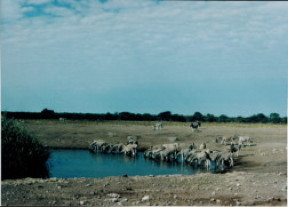
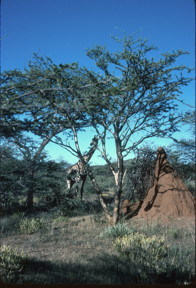
Here are two photos taken at Etosha.
Our quarters at Okaukuejowere disappointing. A row of barracks with small rooms with no view but the next barracks. No stove, so no hot food or morning coffee. But the waterhole that evening made up for everything.
A great flock of Abdim’s Stork came in to roost. Then a flock of sandgrouse.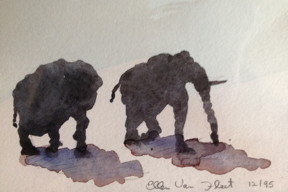
And at dusk 7 elephants moved in quietly like grey ghosts. One was so tiny it never left the shelter of its mother’s belly, and three others were youngsters. They stayed for an hour, drinking and eating grasses around the edges, then left just as quietly. It was wonderful to watch them simply melt into the darkness away from the illuminated area. Ellen later did this evocative painting.
We broke for supper in our room and returned an hour later to find three rhinos there. One came in after the other two and there was a greeting ceremony, like French cheek-kissing. We went to bed feeling that nothing could match this day, and we were right. Next day was all anti-climax, fueled by the fact that it was our last day. I was grumpy, one of the few times I was irritable on the whole trip. The only real highlight was a baby rhino at the waterhole that night. But no more elephants. Went back to Windhoek the next day and then home. And now, 20 years later, just re-reading and writing about it brings a flood of exotic memories. And an ovewhelming gratitude that my life allowed for adventures like this one.
After this was finished I googled Rob and Phoebe and found that they left Namibia in 2003 for South Africa and are researchers at the Percy Fitzpatrick Institute of African Ornithology in Capetown. Rob has published a book on harriers of the world, Phoebe has published extensively on climate change and biodiversity. I will email to alert them to this recovery from the past.

